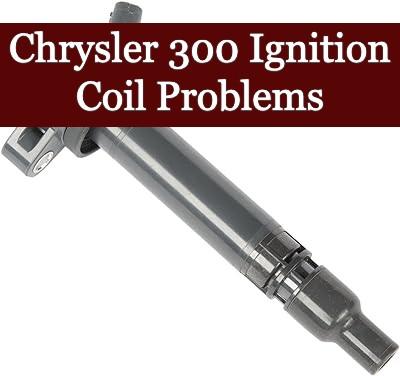Have you ever been cruising down the highway in your Chrysler 300 when suddenly, without warning, your car starts to sputter or stall? If yes, then you might have just encountered an ignition coil issue.
Chrysler 300 ignition coil problems such as the engine misfires or worse yet, your vehicle refusing to start, are like nightmares for any vehicle owner or driver. So, have you ever experienced such an issue? If yes, we’re here for you.
Whether you’re a seasoned motorist puzzled by this unexpected hiccup or a new driver trying to understand this beast under the hood better, we’ve got you covered. Let’s ignite our understanding of these ignition coil problems and explore possible solutions!
Chrysler 300 ignition coil problems

Reports from owners suggest that the most common symptom is misfiring, mainly caused by either worn-out spark plugs or a failing ignition coil. This setback might initially appear minor, but it significantly affects fuel efficiency and power output.
What further adds to the Chrysler 300 ignition coil problems is the heat susceptibility. When exposed to extreme heat, it can prematurely wear out and lead to sporadic engine functioning. Here are some of the common issues and the symptoms experienced by owners.
Car Running Rough and Coil Arcing
Some Chrysler 300 owners complained about experiencing the car running rough and the check engine light blinking. In preliminary inspection, it was found one of the ignition coils was malfunctioning by hearing a clicking sound and seeing it arcing to the valve cover/block.
In such cases, it’s plausible that the coil outputs’ connections to the spring, which in turn connects to the spark plugs, have experienced corrosion. The spark will inevitably follow the path with the least resistance. The boots and output springs can be replaced if necessary.
Additionally, if the vehicle was operated for a period with severely worn spark plugs, this can lead to coil damage due to insulation degradation when the spark plug gap becomes so large that it exceeds what the insulation can withstand, resulting in extremely high output voltage.
The insulation is engineered to manage standard spark voltage, but it fails when it’s required to handle voltages up to 2-1/2 times greater than normal to bridge the gap – something which coil windings are capable of doing, but their insulation isn’t.
A low resistance path for sparks is permanently established once an arc path forms through degraded insulation due to carbonized plastic offering an easier route towards grounding (compared even with a standard spark plug gap), and this condition only worsens as arcing along these paths persists.
However, inspect for corrosion at the coil outputs; it seems like replacement of coils may be necessary because alternate discharge paths have likely been formed regardless of their origin.
There’s still a chance that changing out the boots and output springs could rectify them, though; it might be worth giving it a shot. Apply dielectric grease at connection points (where springs connect with coil output and where springs touch plugs) as well as around the interior of boots where they seal around plug ceramic and its exterior.
Melted Ignition Coil Followed by Starting Issue
Chrysler 300 owners, especially those who had the 2005 300C model, have suffered from a melted coil pack. Initially, some of them have replaced the coil pack. However, after running for a few minutes, the car smoked from the left side and now won’t start.
To be noted, the engine was smoking, but not overheating, and the engine light came on. After changing the melted coil pack and the spark plug, the car won’t start, and the new coil pack was also melted.
If the coil pack persists in overheating to the point of melting, there might be a problem with the corresponding cylinder. Sometimes it can potentially stem from either compression leakage past the spark plug or excessive heat generation within the cylinder.
A melted coil could potentially short-circuit the ignition system, leading to a blown fuse or computer failure. If no electrical anomalies are causing this meltdown, it’s possible that either the connection or coil itself is at fault.
Regardless of these scenarios, an internal short within the wiring harness might be responsible for causing such issues. We recommend replacing the coil first as a precautionary measure. Additionally, ensure that appropriate plugs are installed since incorrect ones can overheat excessively.
Misfiring Cylinder #3
A significant number of Chrysler 300 drivers have reported experiencing an engine misfire problem on Cylinder 3, as indicated by the P0383 error code on their dashboard. Despite replacing the spark plugs in Cylinder 3 and the coil, the issue persists.
To diagnose this problem, it’s crucial to first verify that Injector 3 is functioning correctly. This can be done by placing a thin, long screwdriver on it while the engine is running and listening for a clicking sound at the other end of the screwdriver.
If a click is heard, you’ll need to inspect Spark Plug 3 for sparks. Another diagnostic strategy involves switching out Injector 3 and its coil with ones from another cylinder known to be working well; if the misfire then occurs in this other cylinder, you can rule out these parts as being responsible for the misfire in Cylinder 3.
Before undertaking any substantial engine repair work, it’s recommended that you address potential fuel issues, try spraying some engine oil into Cylinder 3, and check if its compression returns to an acceptable level.
If there’s no improvement, further action might not be necessary as it could indicate that more extensive repairs such as ring replacement or valve adjustments may be required.
How to Replace Chrysler 300 Ignition Coil
When confronted with Chrysler 300 ignition coil problems, some shy away from the challenge, fearing complex wiring diagrams and intricate mechanical puzzles. Yet, the pathway to replacing your car’s ignition coil is a resolutely achievable task even for those who do not profess themselves as experts.
However, once armed with the right knowledge and tools, replacing your car’s ignition coil is nothing short of a rewarding weekend project.
You have to start by disconnecting your battery’s negative terminal: safety first! Locate the ignition coils – you will usually find them on top of the engine assembly.
After removing the electrical connector from each coil, it’s a simple process of unbolting each one and pulling them out with careful firmness. Now comes the exciting part: installing new ignition coils that promise renewed vigor for your beloved Chrysler 300.
Attach them back onto where you took off the faulty ones, and remember to bolt them securely in place, making sure they’re tightly fitted. As crucial as every step is, following these processes religiously; deviating might cause further complications down the line which could escalate existing problems.
Final Words
Issues surrounding the Chrysler 300 ignition coil are not to be overlooked. These problems can significantly impact the performance and longevity of the vehicle. As owners or potential buyers of the Chrysler 300, it is crucial to remain vigilant about such issues and address them promptly when they arise.
Regular maintenance checks focusing on this component can prevent further damage or costly repairs down the line. Finally, we encourage all car owners to invest in quality parts and professional services for their vehicles, thereby ensuring safety and prolonging vehicle life.
Read also:

